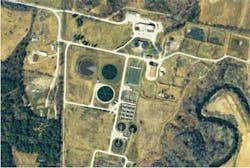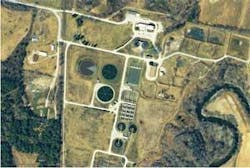Community Plans Combined Heat, Power System using Digester Gas
By Joan Fontaine
This spring, energy and environmental reform assumed political center stage. In March, the EPA rolled out a draft Mandatory Greenhouse Gas Reporting Rule, which was followed shortly by a recommendation to President Obama that greenhouse gas emissions be treated within the context of the Clean Air Act. Congress also weighed in on the matter, first passing the American Recovery and Reinvestment Act with a considerable green bent, and then releasing the draft Clean Energy and Security Act in the House.
But in Western Massachusetts, a small city is waiting for neither regulatory rulings nor legislation to implement energy and environmental reform. Pittsfield, MA., recently completed the preliminary design for an upgrade to its wastewater treatment plant that addresses the issues of renewable energy and energy efficiencies.
The wastewater treatment plant features an anaerobic digester in which some of the digester gas being produced is flared. With the proposed modifications, a combined heat and power (CHP) system will be installed, using three 65-kW rated, skid-mounted microturbines for a total rating of 195 kW. The microturbines will be fueled by the digester gas.
Along with reduced environmental impact, the city will benefit from a reduced utility bill, since the digester gas will be used to generate both electricity and heat for on-site use. In addition, the plant will generate approximately $45,000 a year in revenue through the Renewable Energy Credit market.
Preliminary Design
The preliminary design for the upgrade includes installing a brick and block building to house the entire CHP system, as well as space provisions to add a fourth microturbine in the future. Also included in the preliminary design is the furnishing and installing of a 400A, 480/277V distribution panel sub-fed from the main switchboard in the pump and power building to run the CHP system.
Other key recommendations from the preliminary design include:
- Furnishing and installing three proposed double-disc digested sludge transfer pumps to replace the existing pumps.
- Replacing the existing shell and tube sludge heat exchanger with a single 1.2 MMBTU/hr spiral heat exchanger.
- Installing sufficient instrumentation to monitor sludge and hot water temperatures, as well as pressure drops across the sludge heat exchanger in the sludge and water lines.
- Installing instrumentation to automate sludge mixing through use of a timer and through interlocking mixing operations with sludge pumping.
Sludge Processing
The solids processing infrastructure at the wastewater treatment plant includes primary and waste activated sludge pumping; gravity belt thickeners; thickened waste activated sludge pumps; secondary and primary anaerobic sludge digesters; belt filter presses; and dewatered sludge pumps.
Anaerobic digestion at the facility is a two-stage process. The first stage uses active heating and mixing to facilitate destruction of volatile solids. Mixing is accomplished by re-circulating compressed digester gas from the headspace of the primary digester to the bottom of the vessel through lances. Heating of the primary digester is accomplished by re-circulating sludge through a heat exchanger in the digester building.
A byproduct of the anaerobic sludge digestion process is digester gas, which is primarily comprised of methane (approximately 62 percent by volume) and carbon dioxide. Under the current system, the digester gas (which has a heating value of approximately 620 BTU/SCF) is used as fuel for boilers located in the plant’s pump and power building. The boilers are used to heat a water loop, which then heats the sludge in the digesters and maintains it at the optimal temperature for anaerobic digestion. Excess digester gas is used to heat the pump and power building in the winter or is flared through a waste gas burner located on the top of the digester building.
Under the proposed CHP system, the amount of digester gas flared would be minimized significantly, with much of it being diverted toward a fuel gas conditioning system that removes contaminants from the digester gas – including water vapor, hydrogen sulfide, and siloxanes – and boosts the pressure of the gas to the microturbines. There, the digester gas would be used to make electricity and heat to meet the plant’s baseload demands.
The waste heat created in the exhaust of the CHP system will be used in a heat exchanger to produce hot water. This will be for heating the sludge in the primary digester and as building heat in the digester building. Use of the existing boilers in the pump and power building for sludge heating and building heat may still be required, as there may not be enough heat generated to meet the peak sludge heating requirements under design winter conditions. Nonetheless, the microturbine system is expected to make the boiler system more efficient, as there would be a reduction in the volume of required diesel fuel and process heat.
Conclusion
A feasibility study concluded that a CHP system at the Pittsfield wastewater treatment plant will lead to an estimated 30 percent reduction in the plant’s electric bill – saving taxpayers over $200,000 a year – and have a payback period ranging from five to eight years.
But aside from the beneficial financial and environmental outcomes of this project, there is the potential for Pittsfield to become a model for other municipalities considering similar projects. At the moment, only one other community in New England uses microturbines and digester gas to produce electricity for a wastewater treatment plant: Essex Junction, Vt. which installed two 30-kW rated microturbines back in 2003.
With the reality of greenhouse gas regulations right around the corner, wastewater treatment facilities across the U.S. may be wise to consider environmentally sensitive retrofits and upgrades. And those plants will have to look no further than a small, environmentally conscious city in Western Massachusetts that’s proving that with the right changes “going green” can be a win-win for all. WW
About the author:
Joan Fontaine has over 20 years of engineering experience, 12 years of which have been focused in the energy sector performing mechanical and process design, and analysis for numerous utility projects, as well as managing an array of projects, including a recent $1-million design build project. She has a B.S. in chemical engineering from the University of Lowell and an M.S. in environmental engineering from Rensselaer Polytechnic Institute.

